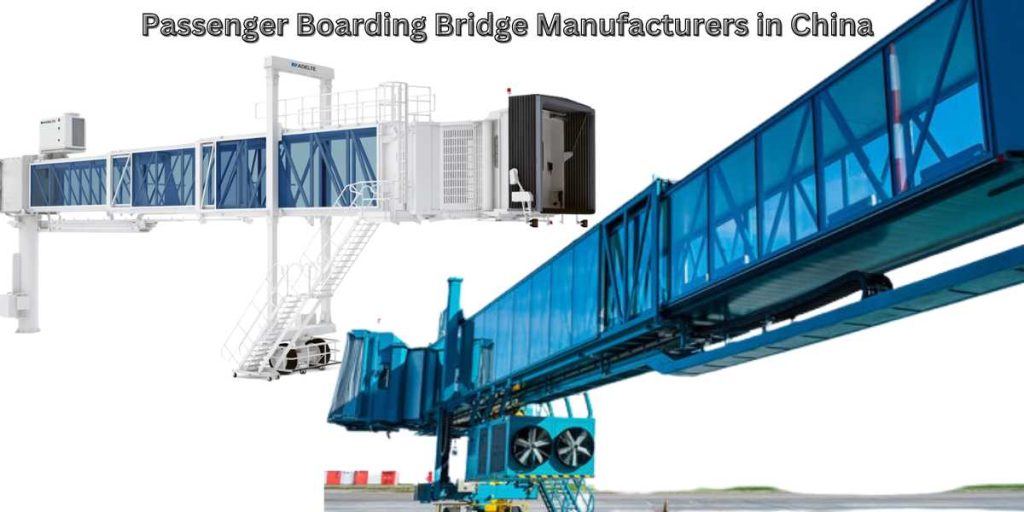Exploring Passenger Boarding Bridges in China in 2025
China’s aviation industry is soaring to new heights, and at the forefront of this growth are the unassuming heroes: passenger boarding bridges (PBBs). These enclosed walkways, also known as jet bridges or airbridges, are the vital link between bustling airport terminals and colossal airplanes. But PBBs are much more than just passageways; they’re marvels of modern engineering, integrating cutting-edge technology with passenger comfort and safety.

China’s PBB Powerhouse: A Manufacturing Marvel
China has emerged as a global leader in PBB manufacturing. Airbridge manufacturers in China, like CIMC-Tianda and Shandong Lingong Machinery Co., Ltd., are churning out innovative PBB solutions for airports worldwide. This dominance extends beyond just quantity. Chinese manufacturers are at the forefront of passenger boarding bridge technology, developing features like:
- Automated PBBs: Imagine a PBB that maneuvers itself to the aircraft door, eliminating the need for manual operation. This futuristic concept is already a reality in China, with airports like Chengdu Tianfu International Airport utilizing these driverless wonders.
- Triple-tunnel PBBs: These behemoths cater to the largest passenger jets, providing a wider and more efficient boarding process for behemoths like the Airbus A380.
A Glimpse into China’s Aviation Industry Trends (2024)
China’s aviation industry is experiencing a period of rapid transformation, and PBBs are reflecting this shift. Here are some key trends shaping the landscape in 2024:
- Sustainable PBBs: Environmental consciousness is a top priority. Manufacturers are focusing on energy-efficient PBBs that utilize lighter materials and optimize energy consumption during operation.
- Biometric Boarding Integration: Imagine a seamless boarding experience where facial recognition allows for quicker passenger verification. The future is here, with several Chinese airports piloting PBBs integrated with biometric boarding systems.
The Future of Air Travel in China
The future of air travel in China is all about optimizing the passenger experience. PBBs are playing a crucial role in achieving this goal:
- Passenger Boarding Process Optimization: Imagine streamlined boarding with minimal waiting times. PBB manufacturers are collaborating with airport authorities to design PBBs that facilitate faster passenger flow.
- Accessibility Features: Inclusivity is paramount. Modern PBBs in China come equipped with features like wider doorways and wheelchair lifts, ensuring a smooth and dignified boarding experience for all passengers.
A Glimpse into Airport Infrastructure
PBBs are just one piece of the puzzle when it comes to efficient airport operations. Here’s a look at how China is approaching airport infrastructure development:
- Airport Terminal Design: Chinese airports are adopting modern terminal designs that prioritize passenger flow and convenience. This includes strategically placed PBBs to minimize walking distances and optimize boarding times.
- Airport Ground Equipment: Alongside PBBs, China is investing in advanced ground equipment like baggage handling systems and automated passenger transportation systems, creating a seamless airport experience.
Safety First: Regulations and Maintenance
Passenger safety is paramount. China adheres to stringent safety regulations for PBBs, ensuring these structures meet the highest international standards. Boarding bridge maintenance in China is also a top priority, with regular inspections and rigorous maintenance schedules in place.
Building the Bridges of the Future
The manufacturing process of PBBs in China is a marvel of efficiency. Passenger boarding bridge factories in China utilize advanced robotics and automation to ensure consistent quality and timely production.
Conclusion: A Gateway to a Connected World
Passenger boarding bridges in China are much more than just metal structures; they are testaments to China’s engineering prowess and commitment to innovation. As China’s aviation industry continues to soar, PBBs will undoubtedly play a pivotal role in shaping the future of air travel, not just in China, but globally. These technological marvels are the vital link connecting passengers to their journeys, and with continuous advancements, they promise a future of seamless, efficient, and comfortable air travel experiences.
Price List
While it’s difficult to provide a single, definitive price for a passenger boarding bridge (PBB) in China due to customization options, we can explore some factors affecting the cost:
- Bridge type: Simpler, single-tunnel bridges for smaller aircraft will be less expensive than complex, triple-tunnel bridges designed for behemoths like the A380.
- Features: Automated PBBs with advanced functionalities will naturally cost more than basic manual bridges.
- Manufacturer: Prices can vary between different manufacturers in China.
Here’s a rough estimate:
Based on information from various Chinese trade platforms, a basic, single-tunnel PBB in China could range from 2 million to 4 million yuan (approximately $300,000 to $600,000 USD). However, keep in mind this is a ballpark figure, and the actual cost can be higher or lower depending on the specifics mentioned above.
Getting an accurate quote:
The best way to determine the exact price for a PBB in China is to contact reputable passenger boarding bridge manufacturers in China directly. They can provide a customized quote based on your specific needs and requirements.






